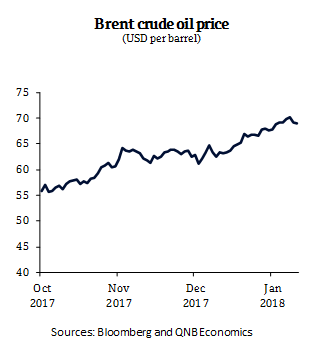All has been well in the global oil market lately. Prices briefly crossed the USD70 per barrel (/b) mark last week – their highest level in three years– and had been rising throughout most of the previous quarter. This caps what was an impressive year for global oil. The market switched from being over-supplied by 0.9mb/d in 2016 to under-supplied by 0.3mb/d in 2017. Driving this change was robust global demand and the Organisation of Petroleum Exporting Countries (OPEC) production cut agreement which constrained supply growth. In assessing the recent rise in oil prices, both demand and supply factors have been supportive of prices but demand has had a larger role in driving higher prices.
Brent crude oil price
(USD per barrel)
Sources: Bloomberg and QNB Economics
Nearly two-thirds of oil’s rise from around USD55/b in October to current levels near USD70/b is attributable to higher global demand. This is according to a model from the Federal Reserve Bank of New York (NYFed) which decomposes the drivers of prices changes in terms of demand and supply and consistent with the raft of positive global activity data witnessed over this period. Purchasing Managers Indices (PMI) in the US, China and the Euro Area either reached or hovered around their highest levels of the year in Q4 2017.Global goods trade volumes continued to expand at over 4% in the final months of 2017, compared to sub-3% at the start of the year. The US in particular, the largest oil consumer with over 20% of global consumption, appears to be the strongest driver of oil demand. In the fourth quarter of 2017,consumption of petroleum products rose by the fastest rate since mid-2016 and oil inventories declined to their lowest level of the year.
While less significant than demand, supply side influences have still been an important driver,explaining the remaining one third of the change in oil prices according to the NYFed model. Here, there are two main dynamics at play. The first is the OPEC supply cuts. OPEC and its non-OPEC partners announced in late November anextension of theiroutput cut agreement until the end of 2018. The extension of the agreement had been clearly telegraphed well before the formal decision date, which supported prices in advance of the late November decision date. Additionally, high compliance with the agreement towards the end of 2017, especially among non-OPEC countries has also aided prices. The second dynamic is heightened geopolitical regional risks during late 2017 which have created concerns about supply, pushing up prices.
These developments have important implications for the future direction of oil prices. Overall, itseems as though the risks are tilted to the downside and sustaining oil prices around USD70/b over the medium-term will be a challenge. In terms of demand, there are clear risks to Chinese oil demand as the economy slows. China’s state-owned petroleum corporation announced that the pace of oil imports is projectedto ease slightly in 2018 to 4.6% growth from 5.9% in 2017. While on the supply side, downward pressure could come from a number of sources. Geopolitical tensions could abate or speculation about a possible OPEC exit strategy could increase. But perhaps the biggest risk is US shale producers boosting production in response to the current high price environment. Several reports indicate that US

